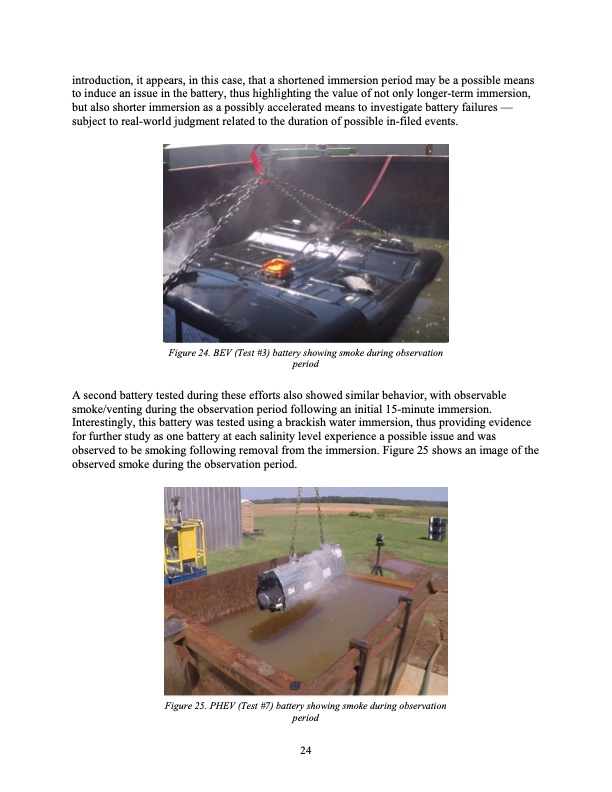
PDF Publication Title:
Text from PDF Page: 028
introduction, it appears, in this case, that a shortened immersion period may be a possible means to induce an issue in the battery, thus highlighting the value of not only longer-term immersion, but also shorter immersion as a possibly accelerated means to investigate battery failures — subject to real-world judgment related to the duration of possible in-filed events. A second battery tested during these efforts also showed similar behavior, with observable smoke/venting during the observation period following an initial 15-minute immersion. Interestingly, this battery was tested using a brackish water immersion, thus providing evidence for further study as one battery at each salinity level experience a possible issue and was observed to be smoking following removal from the immersion. Figure 25 shows an image of the observed smoke during the observation period. Figure 24. BEV (Test #3) battery showing smoke during observation period Figure 25. PHEV (Test #7) battery showing smoke during observation period 24PDF Image | Li-Ion Battery Pack Immersion Exploratory Investigation

PDF Search Title:
Li-Ion Battery Pack Immersion Exploratory InvestigationOriginal File Name Searched:
dot_57013_DS1.pdfDIY PDF Search: Google It | Yahoo | Bing
Product and Development Focus for Salgenx
Redox Flow Battery Technology: With the advent of the new USA tax credits for producing and selling batteries ($35/kW) we are focussing on a simple flow battery using shipping containers as the modular electrolyte storage units with tax credits up to $140,000 per system. Our main focus is on the salt battery. This battery can be used for both thermal and electrical storage applications. We call it the Cogeneration Battery or Cogen Battery. One project is converting salt (brine) based water conditioners to simultaneously produce power. In addition, there are many opportunities to extract Lithium from brine (salt lakes, groundwater, and producer water).Salt water or brine are huge sources for lithium. Most of the worlds lithium is acquired from a brine source. It's even in seawater in a low concentration. Brine is also a byproduct of huge powerplants, which can now use that as an electrolyte and a huge flow battery (which allows storage at the source).We welcome any business and equipment inquiries, as well as licensing our flow battery manufacturing.| CONTACT TEL: 608-238-6001 Email: greg@salgenx.com | RSS | AMP |